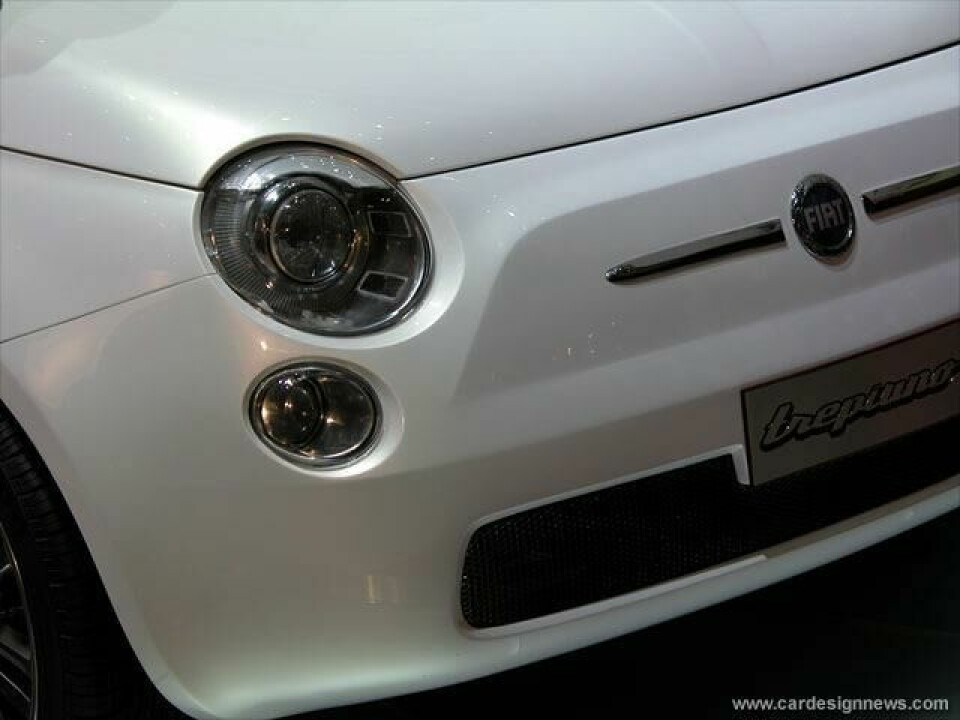
Fiat Trepiùno concept - Design Review
Mar 26, 2004 – Fifty years ago in austere post war Europe there were four peoples’ cars, newly launched or about to be launched: Ferdinand Porsche’s Volkswagen Beetle of 1945, Pierre Boulanger’s Citroen 2CV of 1948, Dante Giacosa’s Fiat 500 Nuovo of 1957 and Alec Issigonis’s Austin Mini of 1959. Because they were so functional and uniquely characterful, they sold in large numbers












The Fiat Advanced Design team. Responsible for the Trepiùno were: Humberto Rodriguez: Head of Style Department, Roberto Giolito: Head of Advanced Design, Salvatore Cacciatore: Chief Designer Concept Lab (Adv. Design), Rossella Guasco: Chief Design Materials Lab (Adv. Design), Guido Bianco: Chief Designer Automotive Lab (Adv. Design), Andreas Wuppinger: Senior Designer Fiat Trepiuno, Matteo Caffagni: Designer, Ruben Wainberg: Designer
Mar 26, 2004 – Fifty years ago in austere post war Europe there were four peoples’ cars, newly launched or about to be launched: Ferdinand Porsche’s Volkswagen Beetle of 1945, Pierre Boulanger’s Citroen 2CV of 1948, Dante Giacosa’s Fiat 500 Nuovo of 1957 and Alec Issigonis’s Austin Mini of 1959. Because they were so functional and uniquely characterful, they sold in large numbers, stayed in production for several decades and became iconic designs inextricably associated with their national identity.
In 1994, 17 years after they sold the last Beetle in Europe, Volkswagen presented the Concept One that previewed the ‘retro’ production Volkswagen Beetle of 1998. In 1997 BMW showed the Spiritual, and then in 2000 the ACV30 concept, before launching the ‘retro’ production Mini in 2001.
With Citroen so far ignoring the opportunity to produce a literal update of the 2CV, even if the C3 and Pluriel make nods in its direction, it has fallen to Fiat now with the Trepiùno concept car designed by Fiat’s Advanced Design group, to show the next reinterpretation of an iconic post war peoples’ car.
Like Volkswagen, Fiat has replaced the original design’s rear engine, rear wheel drive configuration with a front wheel drive platform (likely to be a shortened version of the Panda for a subsequent production car, although the show car was based on a shortened Punto platform), which results in a longer front overhang than the original. In combination with a short rear overhang, this gives the Trepiùno a dynamic imbalance that is further accentuated by a far forward reaching windscreen and diving profile.
This dynamism is a much sought after characteristic in many car designs, although not evident in the original 500’s balanced profile which provides a static solidity to compensate for its diminutive stature.
The Trepiùno’s clamshell bonnet closely echoes its forbearer, as does the feature line that loops around the whole car, and the pair of twin circular front lamps flanking the Fiat graphic mark and chrome sidebars. The soft but strong roundness of the original is also in the new design, particularly in plan, and the roof glazing makes clear reference to the short canvas roof of later 500s, whilst at the rear some modern Fiat family design is evident with lamps and bumper similar to the (now facelifted) Stilo.
Inside, the Trepiùno has a simple IP design and single instrument (speedometer) binnacle similar to the original 500’s, but moves away from retro design influences with an innovative 3+1 seating arrangement where the front passenger is staggered further forward than the driver to provide space for the third occupant behind them, and a ‘+1’ seat space is behind the driver.
Another major innovation inside the car is the ‘MultiController’, a new take on an integrated minor control interface system (like BMW’s i-drive) which sits between the front seats; where the engine start and choke levers used to be on the original car. This system has a translucent silicon surface, similar to that on an iPod, covering a new pressure sensitive fabric called ‘ElekTex’ which works like a switch depending on which area is touched, and has a soft light behind the specific ‘switch’ area that glows more brightly when activated.
Multicontroller, developed by a team led by James Hope of Johnson Controls in Burscheid Germany, frees the design from mechanical switches and provides a seamless interface surface that even a spilt cappuccino would not damage!
At 3.3 metres, the Trepiùno is midway between a Smart ForTwo and a B-class car in length, and along with the Opel Trixx, points the way to a future three occupant class typology, as also identified by Nick Hull in his review of the Trixx. Its retro design will not engender the car with the unique iconic status or be so wholly attributable in conception to one man as the original 1957 500 was. But if the Trepiùno makes production without significant alteration to its uniquely functional and emotive design, then it looks set to address the needs and desires of first time buyers in a way no other car in Europe can. It just could be the much needed success Fiat so desperately needs.










Multicontroller

Color and materials study



